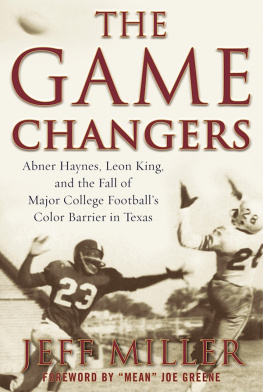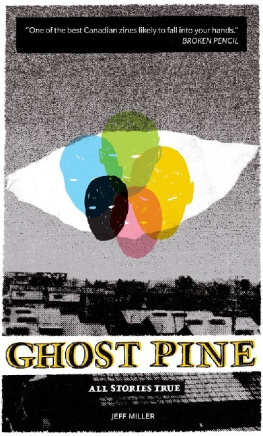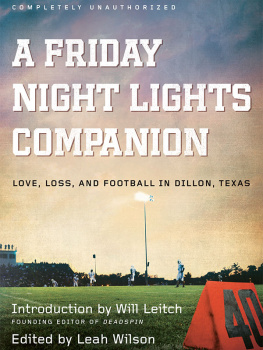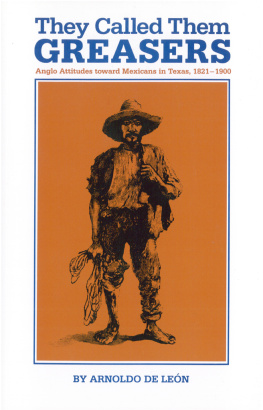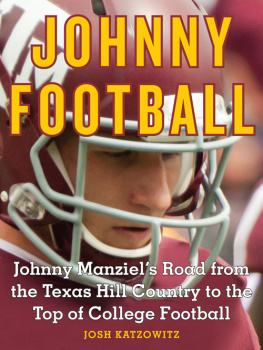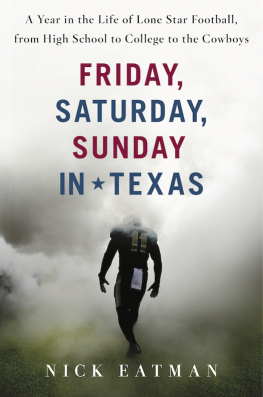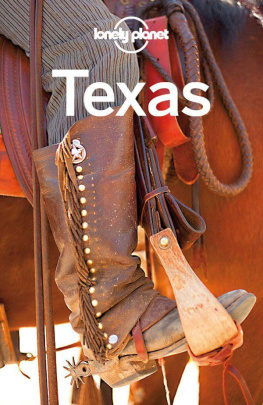Copyright 2016 by Jeff Miller
All rights reserved. No part of this book may be reproduced in any manner without the express written consent of the publisher, except in the case of brief excerpts in critical reviews or articles. All inquiries should be addressed to Sports Publishing, 307 West 36th Street, 11th Floor, New York, NY 10018.
Sports Publishing books may be purchased in bulk at special discounts for sales promotion, corporate gifts, fund-raising, or educational purposes. Special editions can also be created to specifications. For details, contact the Special Sales Department, Sports Publishing, 307 West 36th Street, 11th Floor, New York, NY 10018 or .
Sports Publishing is a registered trademark of Skyhorse Publishing, Inc., a Delaware corporation.
Visit our website at www.sportspubbooks.com.
10 9 8 7 6 5 4 3 2 1
Library of Congress Cataloging-in-Publication Data is available on file.
Cover design by Tom Lau
Cover photo credit: University of North Texas
ISBN: 978-1-61321-937-9
Ebook ISBN: 978-1-61321-942-3
Printed in the United States of America
CONTENTS
FOREWORD
Joe Greene
I HAD A WONDERFUL EXPERIENCE at North Texas. I met my wife, Agnes, there. My two sonsMajor and DeLonplayed football for North Texas. To say that North Texas had an influence on my life and my career is an understatement.
People like Abner Haynes, Leon King, and others who preceded me, softened the experience for me. I was probably nave. Growing up in Temple, Texas in the early 1960s, I didnt have an opportunity to play for the University of Texas, which was only seventy miles away. Same for Baylor, which was only thirty-five miles away. But integration in football was not a pressing interest for me at the time. I was interested in studying accounting, and I read about North Texass business department in a college catalog in the library of my high school, Dunbar High. That was my first encounter with North Texas.
I turned the pages in that catalog, and there was a picture of Abner Haynes. And it mentioned their Sun Bowl team from 1959. I read more and more, and then I investigated North Texas. I had a couple of scholarship offersfrom Texas A&I down in Kingsville, New Mexico State, and the University of Houston. I thought Kingsville was too far. I was going to visit Houston, but the visit coincided with my school prom. Well, the prom was going to win over that.
I sent a letter to North Texas, and they invited me up to visit. I met with head coach Odus Mitchell and assistant coach Fred McCain. I was only 6-foot-3 and 235, maybe 240 pounds. It turns out they saw some game film on me. They offered me a scholarship. After that, I got a visit every other week from Coach McCain and coach Bob Way. I decided that was where I wanted to go.
Coach Mitchell really cared about his players. He was easy to talk to. You could visit with him anytime. He was a very nice manand a very good football coach. Going to North Texas, playing football, and learning from them and from coach Herb Ferrill for three years taught me things that helped me through my entire pro career. I played with some great players and great individuals at North Texas. There was my roommate, Chuck Beattyhe became the mayor of Waxahachie; we call him Hatchetand Cedrick Hardman, Ron Shanklin, Steve Ramsey. We only lost five games through all of my three varsity seasons.
I met Leon King a couple of times. Ive been in the company of Abner frequently after meeting him in 1968 or 69. I saw him a couple of years ago when we both attended a meeting of the North Texas Super Bowl Committee, before the Super Bowl game between the Steelers and the Packers at Cowboys Stadium in 2011. Abner was asked to speak about his experiences at North Texas. It was the first time I heard him talk about that, and the very same things that Id heard from one of Abners teammates, Bill Carrico, about the great togetherness of those North Texas teams. I eventually also had the opportunity to talk to Jerry LeVias about what he went through at SMU, only thirty miles away from Denton, when I was at North Texas.
Im proud of my time at North Texas, and proud of what the school accomplished in the years before me that changed the face of college football in the state of Texas.
Joe Greene did not remain at 235-240 pounds much longer. He became a three-year starter for North Texas when freshmen were still prohibited from participating in varsity competition. He was a three-time All-Missouri Valley Conference performer, and the schools first consensus All-American selection as a senior defensive tackle in 1968.
Greene was selected fourth overall in the 1969 pro football draft by the National Football Leagues Pittsburgh Steelers, earned a starting position before the season began, and was named the NFLs Rookie of the Year that season. Within a few years, Greene and fellow 1969 Pittsburgh draftee L.C. Greenwood were joined by defensive linemen Ernie Holmes and Dwight White to form the famed Steel Curtain. In his thirteen-year NFL career, the 275-pound Greene was named to the All-Pro team five times, selected to the Pro Bowl team ten times, chosen as the leagues Defensive Player of the Year twice, and played for four Super Bowl champions.
Greene was inducted into the College Football Hall of Fame in 1984, the Texas Sports Hall of Fame in 1985, and the Pro Football Hall of Fame in 1987. He was one of the six charter members of the University of North Texas Athletic Hall of Fame in 1981. In April 2013, Greene and Abner Haynes were among the North Texas gridiron standouts selected to the schools All-Century football team. Away from the playing field, Greene in 1983 became the first black appointed to North Texass Board of Regents.
INTRODUCTION
How do you act?
T HE FIRST DAY OF S EPTEMBER 1956 dawned bright and seasonably warm across northern Texas on a Saturday. But in a region of the country that was still morphing fitfully, and to a great degree unwillingly, from the Confederate bloodlines of almost 100 years earlier to a post-World War II American society of inclusion, the racial climate of the day displayed itself through contrasting scenes across the area.
Just south of Fort Worth in the Tarrant County farming community of Mansfield, that Saturday morning found attorneys for the towns school district meeting to plan their latest attempt to prevent a handful of black students from integrating Mansfield High School with the might of the federal judiciary behind them. In front of the students and their families earlier that week, though, stood literally hundreds of angry white citizens who had done whatever they deemed necessary to prevent the students from enrolling. By the time the school districts attorneys gathered quietly that Saturday morning, the hunting dogs from days earlier no longer guarded the school property, and the effigies that had been hung on the schools main flagpole and across Main Street downtown had been removed.
That Saturday afternoon on Fort Worths east side, Lloyd Austin was busy moving his family into a house on North Judkins Street. Maybe Austin was unrealistically optimistic that a black family would be welcomed onto an otherwise all-white block, since there were black families living in the same neighborhood only a few streets away. Maybe he feared brief trouble but thought it would blow over, that it wouldnt be so bad. Austin surely knew otherwise that night, when his new home was surrounded by an estimated 150 whites, some of whom yelled, Get those niggers! Some carried signs, such as I aint no jungle monkey lover, send um back to the dark Congo; some threw rocks; some hung an effigy in his front yard. It wouldnt be his front yard for long. Before the weekend was out, front windows were broken out, screens were ripped, and Austinwho armed himself and fired toward at least one menacing car that drove byabandoned his efforts to move his family into the neighborhood.

